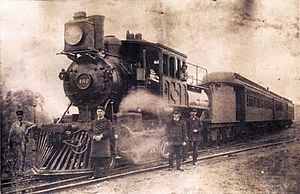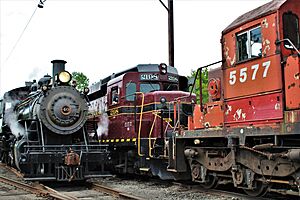New Hope Railroad facts for kids
 |
|
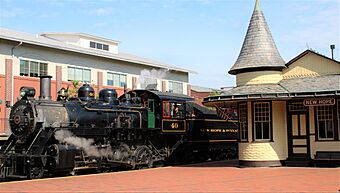
No. 40 at New Hope Station in May 2019
|
|
| Overview | |
|---|---|
| Headquarters | New Hope, Pennsylvania, U.S. |
| Reporting mark | NHRR |
| Locale | Bucks County, Pennsylvania, U.S. |
| Dates of operation | 1966–present |
| Technical | |
| Track gauge | 4 ft 8 1⁄2 in (1,435 mm) standard gauge |
| Length | 18 miles (29 km) |
The New Hope Railroad (NHRR) is a special kind of train line in New Hope, Pennsylvania. It's a shortline, which means it's a shorter railway line. It's also a heritage railroad, which means it keeps old trains running for people to enjoy.
The New Hope Railroad uses both classic steam trains and modern diesel trains. It's a fun way to experience train travel from the past!
Contents
What the Railroad Does
The New Hope Railroad offers two main types of services: fun trips for visitors and moving goods for businesses.
Fun Train Rides
The New Hope Railroad runs exciting trips for people who want to experience a ride on an old train. These trips start in New Hope. You can ride on either a steam-powered train or a diesel-powered train.
Most of the time, the trains travel between New Hope and Lahaska. Sometimes, they even go as far as Buckingham Valley. The railroad uses old passenger cars for these trips. Many of these cars were built a long time ago, between 1914 and 1932. They used to belong to the Reading Company.
Moving Goods for Businesses
Besides fun rides, the New Hope Railroad also helps businesses. It moves raw materials and finished products for different companies. These companies range from large chemical businesses to places that make everyday products.
The New Hope Railroad connects with another railway, the Pennsylvania Northeastern Railroad, in Johnsville. This connection helps them move goods even further. Some of the main businesses they serve are in Warminster, like CRC Industries, Castrol, and Double H Plastics. They get weekly deliveries from the railroad.
History of the New Hope Railroad
The train tracks used by the New Hope Railroad today have a long history. They were originally part of the New Hope Branch of the Reading Company. This line first reached Hartsville Station in 1891. Then, on March 29, 1891, the line was extended all the way to New Hope, Pennsylvania.
In 1932, the steam trains on part of the line were replaced by a special rail car called a Doodlebug. This happened after electric train service started in other areas. Passenger service between Hatboro and New Hope ended in June 1952.
Saving the Railroad
By the early 1960s, the Reading Company was having money problems. They wanted to get rid of train lines that weren't making money. A group of train fans and business people, led by Kenneth Souser, decided to save the line. They started a company called Steam Trains, Inc. Their goal was to run steam trains for fun.
Steam Trains, Inc. became known as the New Hope & Ivyland Railroad (NHIR). On June 20, 1966, they bought the 16.7-mile long train line for $200,000.
The new company started its train operations on August 6, 1966. They bought four steam locomotives and seven passenger cars. They also rented freight trains from the Reading Company. However, the company faced financial difficulties. Steam Trains, Inc. declared bankruptcy on June 5, 1970. But the trains kept running under a special manager.
In 1974, the Bucks County Industrial Development Corporation (BCIDC) bought the tracks. They wanted to make sure train service continued in Bucks County. They chose McHugh Brothers Heavy Hauling, Inc. to run the freight service.
Improvements and New Beginnings
By the summer of 1976, the railroad received money from the state to fix its tracks. These tracks really needed repairs. By August 1977, volunteers from the Buckingham Valley Trolley Association started running passenger service. This connected New Hope with commuter trains in Warminster.
The county's investment paid off. Both passenger and freight services did very well in the 1970s after the track upgrades. Finally, on June 30, 1979, the New Hope Railroad was no longer bankrupt.
Starting July 3, 1980, volunteers from the New Hope Steam Railway (NHOP) took over the weekend train rides. They ran trains until 1990. At that time, the tracks and equipment were again in poor condition.
In 1990, the BCIDC sold the line to the Bucks County Railroad Preservation and Restoration Corporation (BCRP&RC). This company slowly began to rebuild the railroad. They brought it to its good condition that you see today. In 1993, the railroad's official reporting mark became NHRR. BCRP&RC is the company that operates as the New Hope Railroad.
Trains and Cars
The New Hope Railroad has many different types of trains and cars. These include powerful locomotives and various passenger and freight cars.
Locomotives (Engines)
These are the engines that pull the trains.
| Number | Image | Type | Class | Builder | Built | Former owner | Status |
|---|---|---|---|---|---|---|---|
| 40 |  |
Steam | 2-8-0 | Baldwin Locomotive Works | 1925 | Lancaster and Chester Railroad | Operational |
| 1533 | 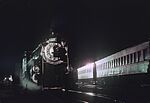 |
Steam | 4-6-0 | Montreal Locomotive Works | 1911 | Canadian National Railway | Stored, awaiting possible restoration |
| 8218 | 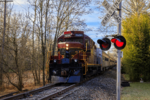 |
Diesel | GP7 | Electro-Motive Diesel | 1957 | Canadian Pacific Railway | Operational |
| 2198 |  |
Diesel | GP30 | Electro-Motive Diesel | 1963 | Pennsylvania Railroad | Operational |
| 5577 |  |
Diesel | SD40-2 | Electro-Motive Diesel | 1972 | Canadian Pacific Railway | Operational |
| 7010 |  |
Diesel | GP9 | Electro-Motive Diesel | 1959 | Canadian National Railway | Operational |
Former Locomotives
These are engines that used to be part of the New Hope Railroad's collection.
| Number | Image | Type | Class | Builder | Built | Former owner | Current owner |
|---|---|---|---|---|---|---|---|
| 9 |  |
Steam | 0-6-0 | American Locomotive Company | 1942 | United States Army, Virginia Blue Ridge Railway | SMS Rail Lines |
| 3028 |  |
Steam | 4-8-4 | American Locomotive Company | 1946 | Ferrocarriles Nacionales de México | ALCO Technical & Historical Society |
| 7087 |  |
Diesel | C30-7 | General Electric | 1981 | Seaboard Coast Line, CSX | None (scrapped) |
Rolling Stock (Train Cars)
These are the cars that are pulled by the locomotives. They include passenger cars for people and freight cars for goods.
| Number | Image | Type | Builder | Built |
|---|---|---|---|---|
| 72 |  |
Baggage car | American Car and Foundry | 1923 |
| 870 | Coach | Bethlehem Steel Company | 1932 | |
| 983 | 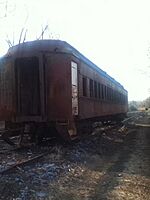 |
Coach | Central Railroad of New Jersey | 1923 |
| 1096 | Tool car | Pullman-Standard Corporation | 1960 | |
| 1127 |  |
Coach | Harlan and Hollingsworth | 1924 |
| 1220 |  |
Coach | Harlan and Hollingsworth | 1922 |
| 1424 | Coach | Harlan and Hollingsworth | 1914 | |
| 1430 | Dining car | Harlan and Hollingsworth | 1914 | |
| 1505 | Coach | Harlan and Hollingsworth | 1916 | |
| 1525 |  |
Open-air car | Harlan and Hollingsworth | 1927 |
| 1536 | 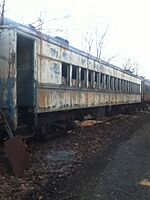 |
Coach | Harlan and Hollingsworth | 1927 |
| 2817 | Event car | Long Island Rail Road | 1955 | |
| 4907 |  |
Dining car | Canadian Car and Foundry | 1919 |
| 9123 | Coach | Bethlehem Steel Company | 1932 | |
| 800301 | Dining car | American Car and Foundry | 1949 | |
| 303 |  |
Hopper car | Pullman Standard | 1955 |
| 1606 |  |
Tank car | Fleischmann Transportation Company | 1948 |
| 1753 | Tank car | Pennsylvania Tank Car Co. | 1927 | |
| 3752 | 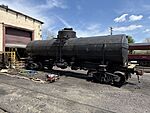 |
Tank car | Union Tank Car Company | 1936 |
| 6622 | Tank car | ACF | 1940 | |
| 8435 | 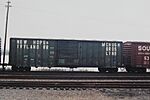 |
Boxcar | Magor Car Corp. | 1931 |
| 1113 | 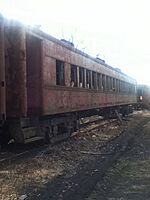 |
Coach | Harlan and Hollingsworth | 1924 |
| 1366 | 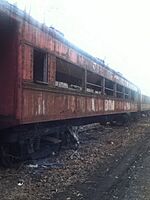 |
Open-air car | Harlan and Hollingsworth | 1918 |
| 8570 | Boxcar | Magor Car Corp. | 1934 | |
| 9005 | Boxcar | Despatch Shops Inc. | 1942 | |
| 9811 | Boxcar | Pullman Standard | 1952 | |
| 12153 | Hopper | Bethlehem Steel | 1944 | |
| 38009 | Flatcar | Magor Car Corp. | 1951 | |
| 53033 | Dump car | Eastern Car Ltd. | 1957 | |
| 480047 | Flatcar | Pennsylvania Railroad Samuel Rea Shops | 1959 | |
| C127 | 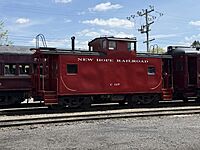 |
Caboose | Laconia Car Company | 1921 |
See also
- List of heritage railroads in the United States
- Pennsylvania Northeastern Railroad
- New Hope Railroad 40


